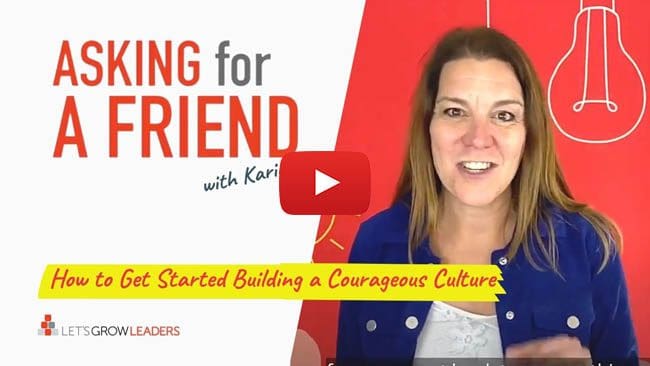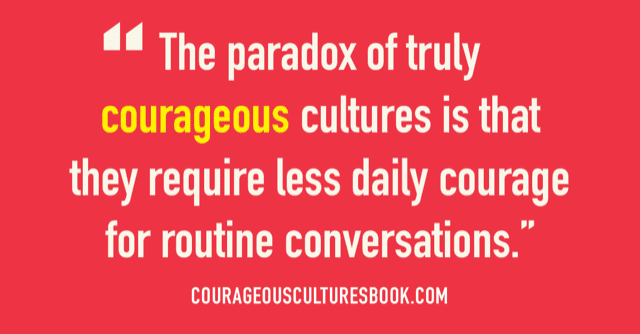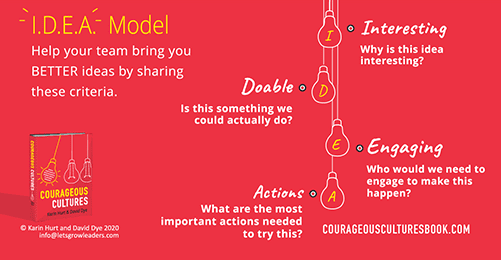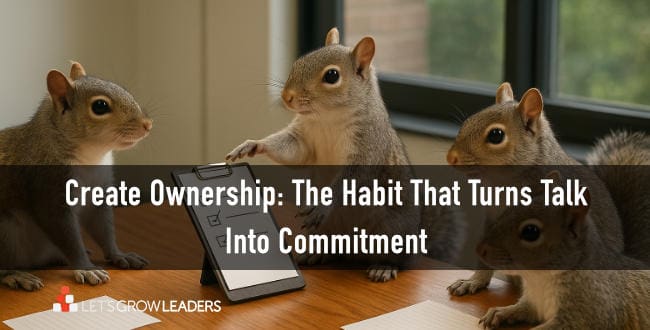Build a More Courageous Culture
Want to build more innovation into your culture, but don’t know where to start? Today we offer a few quick ways to get started on building a courageous culture.
1. Start small to Build a More Courageous Culture
There’s no need to run out and tell your team, “We’re going to build a courageous culture!”
Start by being clear with your team about two key messages.
First that you really do want their ideas and contributions. That it’s not only safe to speak up, but that it’s expected.
And second, go ask your team for ideas in one specific area.
For example, “Can you give me one idea that would help make your life easier and more productive as you’re working from home?”
2. Answer their unspoken questions
Any time you start working on culture, your team will have questions of their own. Work the answers into your communication, BEFORE they have to ask.
- What do you actually mean?
- Why does it matter?
- Can I trust you?
- What is expected of me?
Karin dives a bit deeper into these questions here.
4 Steps to Get Started Building an Innovative Culture

3. Get started reading Courageous Cultures Together
We’ve made it easy to get started reading the book and sharing the tools with your team.
The first tracks section of Courageous Cultures makes it easy to get started on your courageous culture journey. These are tools, best practices, and approaches you can use to build a courageous culture within your team. We designed these tools to build on one another, so we encourage you to do them sequentially. We’re deliberate about inviting you to start small and build momentum as you go—picking a few key areas to work on before thinking more broadly about your entire organization.
We’ve also built a fillable PDF Executive Strategy Guide you can use to record your ideas as you use the tools and reflect on your progress.
4. Discuss what you’re learning
In our Courageous Cultures Live-Online programs, we often use our Let’s Grow Leaders Learning Lab to invite participants to share their biggest takeaways from the book.
Here are a few that have come in recently.
On FOSU (Fear of Speaking Up)
- There are lots of reasons why people have FOSU and the best way to eliminate their fears is to lead by example and create a safe environment for all ideas.
- Clarity and curiosity! I need to get over my FOSU. I also enjoyed the honey crisp story!
- My biggest take away so far is the psychology behind safe silence. Overestimating current risk and underestimating the future benefit really struck a chord. It makes it easier to understand why I fear speaking up but also allows m
e to break through that and speak up anyway.
- Reading the descriptions of toxic cultures has let me release a huge weight of feeling I failed in past situations. It wasn’t just my fault that the problems existed; I was fighting against culture and managers not willing to change.
Balancing Clarity and Curiosity
- The balance between clarity and curiosity is an ongoing effort and that we have to all be in together from the top down for it to be most effective.
- I think my biggest take away is the importance of constant and consistent focus on clarity both from the individual and the team to ensure aligned success.
- The balance of clarity and curiosity is one of the most important takeaways I got from the book. You need to have a healthy dose of both to foster a Courageous Culture. The “Curiosity Chapter” is one of my favorites in the book. There are a lot of great examples throughout the book of different businesses creating Courageous Cultures but the example about Laura the IT Vice President sitting down with the customer service rep is a great one. Laura thought everything was going great with the new systems they implemented because she hadn’t heard anything from her team. Turns out the system was failing their team in multiple ways but the team wasn’t speaking up and sharing their thoughts on the new system. This example really drove the point home for me that there are many great ideas that aren’t shared because people don’t think leadership wants their ideas, no one asks, they lack confidence, they lack the skills to share effectively, or they don’t think anything will happen. Creating a culture that allows employees to speak up is vital to professional growth and development not only for the employee but for the company as well. We do a good job of allowing all employees the chance to be “curious” but it’s important for our company to continue building clarity so that we can use both clarity and curiosity in harmony to grow and become more efficient.
How to Encourage Courage
- That we need to foster an environment that encourages people to feel rewarded and respected when they speak up.
- Realizing that thinking you create a culture of openness, but then learning that maybe it’s not an open environment. The need for psychological safeness takes more than an assumption.
- The practical tools and techniques to make this happen.
- The I.D.E.A. model
- The importance of asking courageous questions.
The Importance of Tapping into Everyone’s Ideas
- My biggest takeaway from the book is how important speaking up is. No matter the perceived importance of an issue, suggestion, or idea, it’s typically better to speak your mind rather than stay quiet. A lot of that comes down to the environment that upper management has created but if there is a less than ideal space for sharing, it’s better to bring that to people’s attention and attempt to foster a more open environment.
- Glad that we’re all reading. Interested to hear how we can tailor some of these ideas to our company to keep improving in a high growth environment with constant change.
- “Your concern matters. We need to care enough to speak the truth.” from page 66 and the story of George and the Humvee! In past jobs, I’ve been hesitant to speak up because I felt as though I wasn’t high up enough in the company to have a voice that mattered. My opinion does matter, and I should always speak my mind with my team!
- All voices must be heard to make an organization function at it’s highest level.
- Company culture is intentional. No matter our level in the organization it is our responsibility to take an active role in the culture. That means speaking up and not accepting the status quo as the only path forward.
 Ready to Get Started?
Ready to Get Started?
Courageous Cultures is available in hardback, kindle, or audio (read by us). Or, in quantity discounts from BookPal.








Do you mind if I quote a few of your posts as
long as I provide credit and sources back to your site? My blog site is in the exact same area of interest as yours and my users would definitely benefit
from a lot of the information you provide here. Please let me know if this
alright with you. Thank you!
That would be fantastic. That’s for helping us spread the word and encouraging courage.